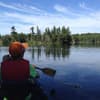Podcast
Questions and Answers
What is the primary concern regarding the construction of the oil pipeline near the Standing Rock Sioux Nation?
What is the primary concern regarding the construction of the oil pipeline near the Standing Rock Sioux Nation?
- Increased property taxes for residents near the pipeline.
- Reduced access to hunting grounds for tribal members.
- Potential contamination of the river and drinking water sources. (correct)
- Disruption of local traffic due to construction activities.
How did the Flint River become a source of dangerous drinking water in Flint, Michigan?
How did the Flint River become a source of dangerous drinking water in Flint, Michigan?
- The river was intentionally poisoned by a terrorist organization.
- A chemical spill from a nearby factory contaminated the river.
- A natural disaster caused the river to flood and mix with toxic waste.
- Government officials decided to switch the water source to the Flint River which was filled with lead. (correct)
Which statement accurately reflects the government's initial response to concerns raised by the residents of Flint, Michigan, regarding their drinking water?
Which statement accurately reflects the government's initial response to concerns raised by the residents of Flint, Michigan, regarding their drinking water?
- The government dismissed the residents' reports and claimed the data was inaccurate. (correct)
- The government actively investigated the issue and collaborated with residents to test water samples.
- The government immediately acknowledged the problem and provided bottled water to all residents.
- The government offered financial compensation to residents affected by the contaminated water.
What was one of the materials mentioned that pipelines are used for?
What was one of the materials mentioned that pipelines are used for?
How many tribes are protesting the oil pipeline construction near the Standing Rock Sioux Nation?
How many tribes are protesting the oil pipeline construction near the Standing Rock Sioux Nation?
What prompted the increased levels of lead in the blood of children in Flint, Michigan?
What prompted the increased levels of lead in the blood of children in Flint, Michigan?
What impact did the switch to Flint River water have on the lead levels in children's blood in some neighborhoods?
What impact did the switch to Flint River water have on the lead levels in children's blood in some neighborhoods?
Which of the following is the starting point of the oil pipeline mentioned?
Which of the following is the starting point of the oil pipeline mentioned?
What is the approximate length of the oil pipeline?
What is the approximate length of the oil pipeline?
Which end does the oil pipeline end at?
Which end does the oil pipeline end at?
is ben awesoms
is ben awesoms
Flashcards
Pipeline (Crude Oil)
Pipeline (Crude Oil)
A large conduit designed for the transportation of crude oil across vast distances within the United States.
Pipeline Route
Pipeline Route
The Dakota Access Pipeline originates in North Dakota and terminates in Illinois, spanning approximately 1,100 miles.
Pipeline Risks
Pipeline Risks
Concerns exist regarding potential leaks from the pipeline, which could contaminate the river and impact the drinking water supply for communities, including the Standing Rock Sioux Nation.
Pipeline Protests
Pipeline Protests
Signup and view all the flashcards
Flint Water Crisis
Flint Water Crisis
Signup and view all the flashcards
Lead Exposure Increase
Lead Exposure Increase
Signup and view all the flashcards
Study Notes
- Pipelines are massive conduits transporting crude oil across the US.
- Crude oil is essential to produce clothing, food, gasoline, and furniture.
- One major pipeline begins in North Dakota and terminates in Illinois.
- The pipeline spans 1,100 miles in length.
- Its construction is on land inhabited by the Standing Rock Sioux Nation.
- There are concerns it could leak, polluting the river and impacting drinking water.
- Over 300 tribes protested the construction of the pipeline.
- Drinking water in Flint, Michigan, became contaminated with hazardous levels of lead after the government switched its water source from Detroit to the Flint River.
- The Flint River’s water supply contains lead.
- A single glass of Flint River water has the potential to hospitalize a child.
- Following the water switch, high levels of lead in children's blood doubled or tripled in some areas within 17 months.
- The government of Flint, Michigan, refuted the public's reports regarding the drinking water's danger, dismissing the data as exaggerated or false.
Studying That Suits You
Use AI to generate personalized quizzes and flashcards to suit your learning preferences.





